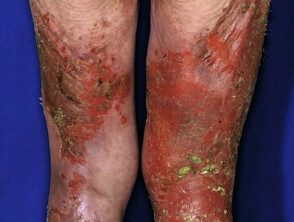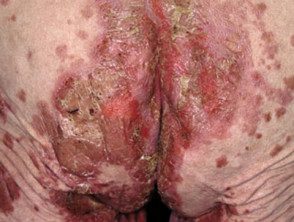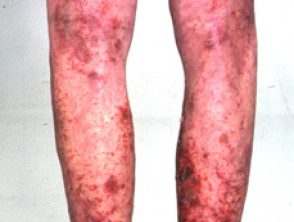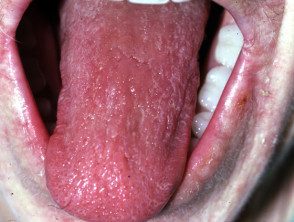What is migratory necrolithic? erythema?
Necrolytic erythema migrans is a characteristic eruption usually occurs in glucagonoma syndrome. Glucagonoma syndrome is due to a slow-growing cancerous cancer. tumor located in the alpha cells of the pancreas. Glucagonoma is very rare and affects adults over 50 years of age. The tumor secretes excessive amounts of the hormone glucagon.
The results of excess glucagon also include:
- Mellitus diabetes
- Weightloss
- Diarrhea
- Neurological and psychiatric symptoms
- Venous thrombosis (blood clots)
- Anemia
- Low levels of circulation amino acids
Other medical conditions can cause a similar rash:
- Hepatic cirrhosis
- Celiac Disease
- Cystic fibrosis causing intestinal malabsorption
- Nutritional deficiencies amino acids, zinc and essential fatty acids
- Rarely, high-dose glucagon treatment for congenital hyperinsulinemia (this is called iatrogenic necrolytic migratory erythema)
What is necrolytic erythema migrans like?
Necrolytic erythema migrans can affect any site, but most commonly affects the genital and anal region, buttocks, groin, and lower legs. The rash fluctuates in severity. Initially there is a ring-shaped red area that blisters, erodes and scabs over. It can be very itchy and painful. As it heals, it may leave a brown mark.
It also results in a mild sore tongue, sore mouth, dry and cracked lips nail.
Necrolytic migratory erythema

Necrolytic migratory erythema

Necrolytic migratory erythema

Necrolytic migratory erythema

Necrolytic migratory erythema

Necrolytic migratory erythema
Necrolytic erythema migrans resembles the rash that occurs in acrodermatitis enteropathica, which is due to zinc deficiency.
How does necrolytic erythema migrans arise?
It is not known how the rash arises. It may be due to a relative deficiency of zinc, amino acids, or essential fatty acids, possibly because the tumor reduces the amount of albumin that normally carries them around the body.
Excess glucagon can increase the amount of inflammation on the skin, particularly at friction sites. It also raises the blood. glucose, which ultimately leads to diabetes mellitus. It destroys proteins and fats, resulting in weight loss, anemia and low levels of amino acids.
How is necrolytic erythema migrans diagnosed?
Blood tests can include:
- Blood count, which can reveal anemia
- Glucose tolerance test, to evaluate diabetes mellitus.
- Liver function, which can detect secondary growths in the liver.
- Serum glucagon levels, which can be up to 1000 times normal
- Amino acid levels, which can be very low.
- Serum insulin, gastrin and intestinal vasoactive peptide levels, which can reveal other endocrine abnormalities
A skin biopsy of necrolytic erythema migrans may reveal inflammation and separation of the superficial layers of the epidermis.
A glucagonoma is usually detected in the tail of the pancreas by computed tomography (Connecticut examination), although conventional chest x-ray, magnetic resonance image (Magnetic resonance) and celiac axis angiography It can also be useful.
What is the treatment for necrolytic erythema migrans?
Necrolytic erythema migrans usually disappears once the glucagonoma tumor has been surgically removed. However, if the tumor has already spread to other organs such as the liver, surgery is not as effective.
While you wait for surgery, somatostatin, a medication that inhibits glucagon, may be helpful. Zinc supplements may result in complete resolution of the rash in some patients.
Chemotherapy Treatments including streptozocin, fluorouracil, dacarbazine, and octreotide may also help some patients.
About 50% of patients die within 5 years of diagnosis of necrolytic erythema migrans.

